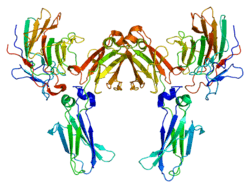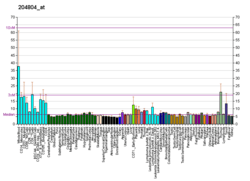TRIM21
Tripartite motif-containing protein 21 also known as E3 ubiquitin-protein ligase TRIM21 is a protein that in humans is encoded by the TRIM21 gene.[5][6] Alternatively spliced transcript variants for this gene have been described but the full-length nature of only one has been determined. It is expressed in most human tissues.[7]
Structure
TRIM21 is a member of the tripartite motif (TRIM) family. The TRIM motif includes three zinc-binding domains, a RING finger domain, a B-box type 1 and a B-box type 2 zinc finger, and a coiled coil region.[6]
Function
TRIM21 is an intracellular antibody effector in the intracellular antibody-mediated proteolysis pathway. It recognizes Fc domain[8] and binds to immunoglobulin G as well as immunoglobulin M on antibody marked non-enveloped virions which have infected the cell. Either by autoubiquitination or by ubiquitination of a cofactor, it is then responsible for directing the virions to the proteasome. TRIM21 itself is not degraded in the proteasome unlike both the viral capsid and the bound antibody.[7]
TRIM21 is part of the RoSSA ribonucleoprotein, which includes a single polypeptide and one of four small RNA molecules. The RoSSA particle localizes to both the cytoplasm and the nucleus.[6]
Clinical significance
RoSSA interacts with autoantigens in patients with Sjögren's syndrome and systemic lupus erythematosus.[6]
TRIM21 can be used to knockout specific proteins with their corresponding antibodies, a method known as Trim-Away. In this assay, TRIM21 and antibodies are delivered into cells through electroporation, and the targeted protein is degraded within a few minutes.[9]
References
- 1 2 3 GRCh38: Ensembl release 89: ENSG00000132109 - Ensembl, May 2017
- 1 2 3 GRCm38: Ensembl release 89: ENSMUSG00000030966 - Ensembl, May 2017
- ↑ "Human PubMed Reference:".
- ↑ "Mouse PubMed Reference:".
- ↑ Frank MB, Itoh K, Fujisaku A, Pontarotti P, Mattei MG, Neas BR (Mar 1993). "The mapping of the human 52-kD Ro/SSA autoantigen gene to human chromosome 11, and its polymorphisms". Am J Hum Genet. 52 (1): 183–91. PMC 1682114. PMID 8094596.
- 1 2 3 4 "Entrez Gene: TRIM21 tripartite motif-containing 21".
- 1 2 Mallery DL, McEwan WA, Bidgood SR, Towers GJ, Johnson CM, James LC (2010). "Antibodies mediate intracellular immunity through tripartite motif-containing 21 (TRIM21)". Proceedings of the National Academy of Sciences of the United States of America. 107 (46): 19985–90. doi:10.1073/pnas.1014074107. PMC 2993423. PMID 21045130.
- ↑ James LC, Keeble AH, Khan Z, Rhodes DA, Trowsdale J (2007). "Structural basis for PRYSPRY-mediated tripartite motif (TRIM) protein function". Proceedings of the National Academy of Sciences of the United States of America. 104 (15): 6200–5. doi:10.1073/pnas.0609174104. PMC 1851072. PMID 17400754.
- ↑ Clift D, McEwan WA, Labzin LI, Konieczny V, Mogessie B, James LC, Schuh M. "A Method for the Acute and Rapid Degradation of Endogenous Proteins". Cell. doi:10.1016/j.cell.2017.10.033.
Further reading
- Jones SK (1992). "Ultraviolet radiation (UVR) induces cell-surface Ro/SSA antigen expression by human keratinocytes in vitro: a possible mechanism for the UVR induction of cutaneous lupus lesions". Br. J. Dermatol. 126 (6): 546–553. doi:10.1111/j.1365-2133.1992.tb00098.x. PMID 1610705.
- Itoh K, Itoh Y, Frank MB (1991). "Protein heterogeneity in the human Ro/SSA ribonucleoproteins. The 52- and 60-kD Ro/SSA autoantigens are encoded by separate genes". J. Clin. Invest. 87 (1): 177–186. doi:10.1172/JCI114968. PMC 295020. PMID 1985094.
- Chan EK, Hamel JC, Buyon JP, Tan EM (1991). "Molecular definition and sequence motifs of the 52-kD component of human SS-A/Ro autoantigen". J. Clin. Invest. 87 (1): 68–76. doi:10.1172/JCI115003. PMC 294993. PMID 1985112.
- Miyagawa S, Okada N, Inagaki Y, et al. (1988). "SSA/Ro antigen expression in simian virus 40-transformed human keratinocytes". J. Invest. Dermatol. 90 (3): 342–345. doi:10.1111/1523-1747.ep12456308. PMID 2450143.
- Chan EK, Di Donato F, Hamel JC, et al. (1995). "52-kD SS-A/Ro: genomic structure and identification of an alternatively spliced transcript encoding a novel leucine zipper-minus autoantigen expressed in fetal and adult heart". J. Exp. Med. 182 (4): 983–992. doi:10.1084/jem.182.4.983. PMC 2192297. PMID 7561701.
- Tsugu H, Horowitz R, Gibson N, Frank MB (1995). "The location of a disease-associated polymorphism and genomic structure of the human 52-kDa Ro/SSA locus (SSA1)". Genomics. 24 (3): 541–548. doi:10.1006/geno.1994.1664. PMID 7713506.
- Frank MB, McCubbin VR, Heldermon C (1995). "Expression and DNA binding of the human 52 kDa Ro/SSA autoantigen". Biochem. J. 305 (2): 359–62. PMC 1136368. PMID 7832745.
- Maruyama K, Sugano S (1994). "Oligo-capping: a simple method to replace the cap structure of eukaryotic mRNAs with oligoribonucleotides". Gene. 138 (1–2): 171–174. doi:10.1016/0378-1119(94)90802-8. PMID 8125298.
- Keech CL, Gordon TP, McCluskey J (1996). "Structural differences between the human and mouse 52-kD Ro autoantigens associated with poorly conserved autoantibody activity across species". Clin. Exp. Immunol. 104 (2): 255–263. doi:10.1046/j.1365-2249.1996.16726.x. PMC 2200432. PMID 8625517.
- Igarashi T, Itoh Y, Fukunaga Y, Yamamoto M (1996). "Stress-induced cell surface expression and antigenic alteration of the Ro/SSA autoantigen". Autoimmunity. 22 (1): 33–42. doi:10.3109/08916939508995297. PMID 8882420.
- Suzuki Y, Yoshitomo-Nakagawa K, Maruyama K, et al. (1997). "Construction and characterization of a full length-enriched and a 5'-end-enriched cDNA library". Gene. 200 (1–2): 149–156. doi:10.1016/S0378-1119(97)00411-3. PMID 9373149.
- Bepler G, O'briant KC, Kim YC, et al. (1999). "A 1.4-Mb high-resolution physical map and contig of chromosome segment 11p15.5 and genes in the LOH11A metastasis suppressor region". Genomics. 55 (2): 164–175. doi:10.1006/geno.1998.5659. PMID 9933563.
- Tseng CE, Miranda E, Di Donato F, et al. (1999). "mRNA and protein expression of SSA/Ro and SSB/La in human fetal cardiac myocytes cultured using a novel application of the Langendorff procedure". Pediatr. Res. 45 (2): 260–269. doi:10.1203/00006450-199902000-00018. PMID 10022600.
- Fabini G, Rutjes SA, Zimmermann C, et al. (2000). "Analysis of the molecular composition of Ro ribonucleoprotein complexes. Identification of novel Y RNA-binding proteins". Eur. J. Biochem. 267 (9): 2778–2789. doi:10.1046/j.1432-1327.2000.01298.x. PMID 10785401.
- Kurien BT, Chambers TL, Thomas PY, et al. (2001). "Autoantibody to the leucine zipper region of 52 kDa Ro/SSA binds native 60 kDa Ro/SSA: identification of a tertiary epitope with components from 60 kDa Ro/SSA and 52 kDa Ro/SSA". Scand. J. Immunol. 53 (3): 268–276. doi:10.1046/j.1365-3083.2001.00870.x. PMID 11251884.
- Reymond A, Meroni G, Fantozzi A, et al. (2001). "The tripartite motif family identifies cell compartments". EMBO J. 20 (9): 2140–2151. doi:10.1093/emboj/20.9.2140. PMC 125245. PMID 11331580.
- Di Donato F, Chan EK, Askanase AD, et al. (2001). "Interaction between 52 kDa SSA/Ro and deubiquitinating enzyme UnpEL: a clue to function". Int. J. Biochem. Cell Biol. 33 (9): 924–934. doi:10.1016/S1357-2725(01)00055-3. PMID 11461834.
- Fukuda-Kamitani T, Kamitani T (2002). "Ubiquitination of Ro52 autoantigen". Biochem. Biophys. Res. Commun. 295 (4): 774–778. doi:10.1016/S0006-291X(02)00750-7. PMID 12127959.
- Strausberg RL, Feingold EA, Grouse LH, et al. (2003). "Generation and initial analysis of more than 15,000 full-length human and mouse cDNA sequences". Proc. Natl. Acad. Sci. U.S.A. 99 (26): 16899–16903. doi:10.1073/pnas.242603899. PMC 139241. PMID 12477932.






